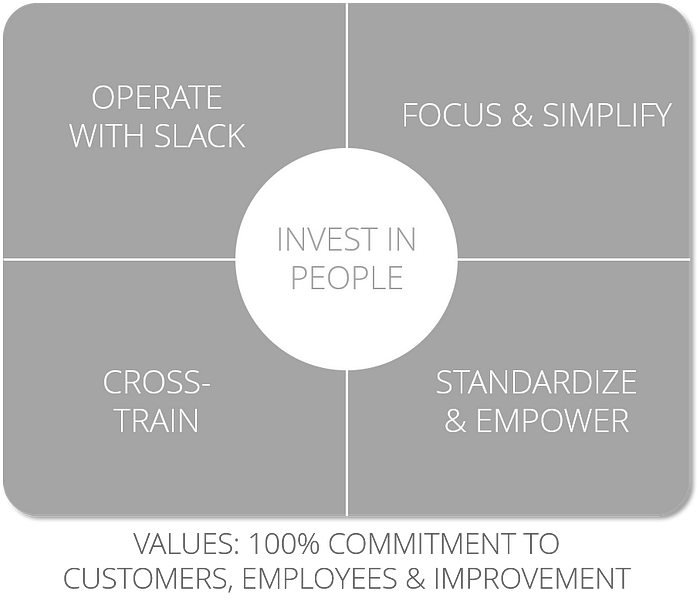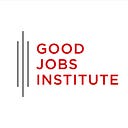What is the Good Jobs Strategy?
How investing in employees can boost sales and lower costs
The Good Jobs Strategy (GJS) is a system, rooted in theory and practice, that combines investment in people with operations and job design choices that raise productivity, contribution, and motivation of employees. Companies that are public and private, in retail and beyond, have used the Good Jobs Strategy to reduce turnover, improve productivity, improve customer service and sales, and build a long-term competitive advantage. These companies include the world’s third largest retailer Costco, call centers of Quest Diagnostics, Trader Joe’s, and convenience store chain QuikTrip.
This article is a brief overview on this system, based on The Good Jobs Strategy: How the Smartest Companies Invest in Employees to Lower Costs and Boost Profits.¹
The Vicious Cycle
The conventional wisdom in competitive, low margin industries with a high concentration of frontline workers — from retail, food service, hospitality, call centers, warehouses, to manufacturing — is to achieve profits through minimizing labor costs. Companies pay their employees as low as they can and operate with as few people as they can. But low people investment puts companies in a vicious cycle of high turnover and poor performance. These companies have operational problems (e.g., misplaced products, long lines, quality issues, bad service, waste/shrink), which lead to lower sales and profits, which leads to lower investment in people, which leads to higher turnover, which starts the cycle all over again by creating even more operational problems.

The Virtuous Cycle
Good jobs companies operate in a virtuous cycle of low turnover and high performance. Instead of seeing employees as a cost to be minimized, they see them as drivers of profit and growth and invest in them through higher wages, more benefits, and career paths. Costco employees, for example, make an average of $24, almost 100% of store managers are promoted from within, and the company’s employee turnover is less than half the industry average. Investing in people allows Costco to attract, retain, and develop great people, who can then better serve their members. Workers who have financial security are better able to take care of their health, focus on their work, and are less likely to leave.
But the virtuous cycle doesn’t operate on its own. Four operational choices fuel that cycle by enabling employees to contribute, increase productivity, and drive improvements.
Leveraging Investment in People Through Operational Choices

Focus & Simplify
Have you wondered why In-N-Out Burger has such a small menu? Or why Trader Joe’s doesn’t offer curbside pickup or delivery? They know why their customers come to them, and then make hard tradeoffs on what they offer and what they want to be best at, which allow for strategic focus.
Once GJS companies identify why their customers come to them, they are disciplined about simplifying their operations to be consistent with their value proposition. This might mean reducing the number of items or services that they sell, eliminating promotions or price changes that take up employee time without adding value to the customer, smoothing workload by scheduling non-customer facing tasks during low-traffic periods, and reducing last-minute changes that can challenge execution at the frontlines.
The combination of strategic focus with operational simplification enables higher employee investment. Because employees are more productive and knowledgeable, they can be paid more. Because workload is smoother, employees can have more stable schedules. It also improves employee motivation by reducing firefighting and non-value add work, fostering a sense of meaningfulness that enables better service.
Standardize & Empower
Mercadona, the largest supermarket chain in Spain, has a standardization and empowerment system to maintain and improve standards. “Process Owners” work with empowered store-level teams to identify problems and improve workflow and standards, ensuring that the customer has the best experience possible and the company maintains operational excellence.
GJS companies like Mercadona combine standardization with empowerment. They standardize tasks that benefit most from efficiencies and consistency, while empowering their employees to improve those standards, adapt to local conditions, and solve customer problems.
If empowerment drives motivation and improvements, why don’t more companies empower their people? In unstable, high-turnover environments, companies introduce top-down standards to maintain consistency. With simplified work and focused standards, employees can start to drive value faster, enabling higher pay and lower turnover. And when tenured employees are more familiar with systems, they can offer better improvement ideas to drive increased productivity and better service.
Cross-Train
Every employee at a QuikTrip is trained to flex into various roles as needed. When there are many customers, they can open up a register, when it is slower, they can keep the store sparkling clean and organize inventory. This helps QT meet their goal of being fast, clean, and friendly, and getting customers in and out in under a minute.
Cross-Train is about balancing flexibility with specialization, which results in higher employee productivity. It is impossible to perfectly predict workload demand for every minute or hour of every day, thus there will inevitably be times when companies have more or less employees than they need.
For Cross Train to be effective, companies first need relevant standards, to ensure consistent execution. With cross-training, employees can respond to various levels of customer demand or step in when someone is sick, making it easier to offer stable schedules. The higher task variety also increases employee achievement and meaningfulness.
Operate with Slack
GJS companies staff higher than the expected workload so they can meet customer demand at the peak periods, keep up on task lists when demand goes down, and provide good work life balance to teams. Operate with Slack comes last in this list for a reason: adding hours can be expensive if you have not simplified work and removed non-value add tasks, standardized work so that you know how long tasks should take and created flexibility with empowerment and cross-training. Then, companies can assess how much slack they need to make sure that employees are always read to service the customer, accomplish non-customer facing tasks that support clean stores, strong inventory, and good service, and give managers time for coaching and development.
Though these operational choices are separated for explanation purposes, it’s important to remember that companies are complex systems, and all the choices are interrelated. And all choices leverage committed, capable, and motivated workforce, which requires investment in people.
Benefits of the GJS: Financial, Competitive, and Ethical
Building a high-performance operational system driven by a capable, motivated workforce has both short-term and long-term benefits.
- Financial Case: compared to their competitors, these companies have lower turnover costs (recruiting, training, productivity ramp), less waste/shrink, less wasted productivity due to operational problems, and higher sales from more engaged and experienced employees.
- Competitive Case: these companies are hyper-focused on why customers come to them and use their superior operating system and tenured employees to offer differentiated service and adapt to/execute on new changes, from regulatory changes to customer preference to pandemics, faster than competitors.
- Ethical Case: higher wages, stable schedules and career paths have tangible effects on the health of individuals and communities. Good jobs demonstrates a belief in and respect for people.
So, if bad jobs are bad for employees, customers, and investors, why are there so many of them? The answer: minimizing costs is profitable. What most companies might not realize is that maximizing contribution is also profitable. It just requires a different system and set of disciplined choices.
But change is possible; many GJS companies were not born that way. A few years ago, Sam’s Club was suffering from high turnover and declining member satisfaction. They pursued a good jobs journey, starting by stabilizing work and stabilizing people: they reduced product variety, removed services like their photo center, increased wages by between $5-$7 for key roles, moved to block scheduling, and gave employees better tools to serve customers. As a result of these changes, Sam’s Club increased revenue and membership and reduced employee turnover by up to 70%.
Can You Offer Good Jobs?
Good Jobs Institute was founded in 2017 as a 501(c)(3) non-profit organization with the mission to help companies thrive by creating good jobs. Our President and Co-Founder Zeynep Ton is a leading retail and service operations expert, Professor of the Practice at MIT Sloan, and author of The Good Jobs Strategy: How the Smartest Companies Invest in Employees to Lower Costs and Boost Profits.
Good Jobs Institute builds partnerships with companies that want to leverage the Good Jobs Strategy to improve employee experience, customer service and operational performance. We also create tools to help any company get to good jobs, such as:
- Good Jobs Scorecard: understand your current performance with employees, customers, and operations
- Good Jobs Calculator: illustrate the financial benefits of a Good Jobs Strategy, including cost mitigation, revenue uplift, and labor productivity gains
- Pay Analysis: calculate the percentage of your full-time employees that are at or below a living wage threshold, with suggested disaggregation by role, tenure, race, and gender
You can also visit our website or contact us to learn more.

¹ Ton, Zeynep, The Good Jobs Strategy: How the Smartest Companies Invest in Employees to Lower Costs and Boost Profits. Boston: New Harvest, Houghton Mifflin Harcourt, 2014.






